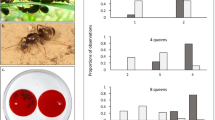Summary
Previous investigations of small colonies (<10 workers each) of Camponotus spp. indicated that queen-derived recognition cues, transferred to and learned by workers, are of major importance in between-colony discrimination (Carlin and Hölldobler 1983, 1986). However, queens may have contributed disproportionately to a communal label or “gestalt” in small colonies. Here we report experiments on groups of approximately 190 sister workers of C. floridanus, adopted to alien conspecific queens. In 1200 neutral arena encounters, adoptees were introduced to their own unfamiliar sisters, reared in their colony of origin; unfamiliar non-sisters were introduced as controls. Following tests of worker behavior, the queens were dissected. Aggression was equally strong in encounters between unfamiliar kin and encounters between nonkin, if the adoptive queen had fully-developed ovaries, was completely inseminated, and produced abundant brood. However, workers were significantly less aggressive in encounters between kin if their queens had less active ovaries and were incompletely inseminated. Thus the presence of a fully functional queen continues to prevent recognition of unfamiliar kin in larger colonies, but worker cues can become more important when the queen is ineffective. In addition, adoptees of productive queens were significantly less aggressive toward pure-colony sisters than the latter were to them, suggesting the involvement of a foreignlabel rejection mechanism (Getz 1982).
Similar content being viewed by others
References
Bartz SH, Hölldobler B (1982) Colony founding in Myrmecocystus mimicus Wheeler (Hymenoptera: Formicidae) and the evolution of foundress associations. Behav Ecol Sociobiol 10:137–147
Bhatkar A (1983) Interspecific trophallaxis in ants, its ecological and evolutionary significance. In: Jaisson P (ed) Social insects in the tropics. Presses de l' Université Paris-Nord, pp 105–123
Bhatkar A, Whitcomb WH (1970) Artificial diet for rearing various species of ants. Fla Entomol 53:229–232
Breed M (1982) Juvenile hormone and aggression in the honey bee. In: Breed M, Michener C, Evans H (eds) The Biology of Social Insects. Westview, Boulder, Colo, pp 233–237
Breed M, Butler L, Stiller T (1985) Kin discrimination by worker honey bees in genetically mixed groups. Proc Nat Acad Sci USA 82:3058–3061
Buckle G, Greenberg L (1981) Nestmate recognition in sweat bees (Lasioglossum zephyrum): Does an individual recognize its own odour or only odours of its nestmates? Anim Behav 29:802–809
Carlin NF, Hölldobler B (1983) Nestmate and kin recognition in interspecific mixed colonies of ants. Science 222:1027–1029
Carlin NF, Hölldobler B (1986) The kin recognition system of carpenter ants (Camponotus spp.) I: Hierarchical cues in small colonies. Behav Ecol Sociobiol 19:123–134
Cole BJ (1981) Dominance hierarchies in Leptothorax ants. Science 212:83–84
Crozier R (1987) Genetic aspects of kin recognition: Concepts, models and synthesis. In: Fletcher D, Michener C (eds) Kin recognition in animals. John Wiley and Sons, New York (in press)
Crozier R, Dix M (1979) Analysis of two genetic models for innate components of colony odor in social Hymenoptera. Behav Ecol Sociobiol 4:217–224
De Vroey C, Pasteels J (1978) Agonistic behavior of Myrmica rubra L.. Insectes Sociaux 25:247–265
Edwards J, Chambers J (1984) Identification and source of a queen-specific chemical in the pharaoh's ant Monomorium pharaonis (L.). J Chem Ecol 10:1731–1747
Fielde A (1904) Power of recognition among ants. Biol Bull 7:227–250
Fletcher DJC, Blum M (1983) Regulation of queen number by workers in colonies of social insects. Science 219:312–314
Forel A (1923) Le monde social des fourmis, vol 4. Libraire Kundig, Geneva
Franks N, Sovell E (1983) Dominance and reproductive success among slave-making worker ants. Nature 304:724–725
Freeman LC (1965) Elementary applied statistics. Wiley, New York
Gadagkar R (1985) Kin recognition in social insects and other animals—a review of recent findings and a consideration of their relevance for the theory of kin selection. Proc Indian Acad Sci (Anim Sci) 94:587–621
Gamboa G, Reeve H, Pfennig D (1986) The evolution and ontogeny of nestmate recognition in social wasps. Ann Rev Entomol 31:431–454
Getz WM (1982) An analysis of learned kin recognition in Hymenoptera. J Theor Biol 99:585–597
Getz WM, Smith K (1983) Genetic kin recognition: honey bees discriminate between full and half sisters. Nature 302:147–148
Getz WM, Bruckner D, Smith KB (1986) Conditioning honey-bees to discriminate between heritable odors from full and half sisters. J Comp Physiol A 159:251–256
Goldstein M, Topoff H (1985) Reaction of the ant Novomessor albisetosus Mayr to intruders in the nest area (Hymenoptera: Formicidae). Insectes Sociaux 32:173–185
Hölldobler B (1962) Zur Frage der Oligogynie bei Camponotus ligniperda Latr. und Camponotus herculeanus L. (Hym. Formicidae). Z Angew Entomol 49:337–352
Hölldobler B (1976) Recruitment behavior, home range orientation and territoriality in harvester ants, Pogonomyrmex. Behav Ecol Sociobiol 1:3–44
Hölldobler B (1984) Evolution of insect communication. In: Lewis T (ed) Insect communication. Academic, London, pp 349–377
Hölldobler B, Bartz S (1985) Sociobiology of reproduction in ants. In: Hölldobler B, Lindauer M (eds) Experimental behavioral ecology and sociobiology. Fischer, Stuttgart, pp 237–258
Hölldobler B, Michener C (1980) Mechanisms of identification and discrimination in social Hymenoptera: In: Markl H (ed) Evolution of social behavior: hypotheses and empirical tests. VCH, Weinheim, pp 35–58
Le Moli F, Parmigiani S (1981) Laboratory and field observations of attack by the red wood ant Formica lugubris Zett. on Formica cunicularia Latr. (Hymenoptera: Formicidae). Aggressive Behav 7:341–350
Linsenmair K (1985) Individual and family recognition in subsocial arthropods, in particular the desert isopod Hemilepistus reaumuri. In: Hölldobler B, Lindauer M (eds) Experimental behavioral ecology and sociobiology. Fortsch Zool 31:237–258
Mintzer A (1982) Nestmate recognition and incompatibility between colonies of the acacia ant Pseudomyrmex ferruginea. Behav Ecol Sociobiol 10:165–168
Mintzer A, Vinson S (1985) Kinship and incompatibility between colonies of the acacia ant Pseudomyrmex ferruginea. Behav Ecol Sociobiol 17:75–78
Otto D (1958) Über die Arbeitsteilung im Staate von Formica rufo-pratensis minor Gössw. und ihre verhaltensphysiologischen Grundlagen. Wissenschaftl Abhandl Nr 30 der Dtsch Akad Landwirtschaftswiss Berlin. Akademic, Berlin
Page RE (1986) Sperm utilization in social insects. Ann Rev Entomol 31:297–320
Pfennig D, Reeve H, Shellman J (1983) Learned component of nestmate discrimination in workers of a social wasp, Polistes fuscatus (Hymenoptera: Vespidae). Anim Behav 31:412–416
Pricer JL (1908) The life history of the carpenter ant. Biol Bull 14:177–218
Stuart R (1985) Nestmate recognition in leptothoracine ants: exploring the dynamics of a complex phenomenon. Ph D thesis, University of Toronto
Stuart R, Alloway T (1983) The slave-making ant, Harpagoxenus canadensis M.R. Smith, and its host-species, Leptothorax muscorum (Nylander): Slave raiding and territoriality. Behaviour 85:58–90
Visscher K (1986) Kinship discrimination in queen rearing by honeybees (Apis mellifera). Behav Ecol Sociobiol 18:453–460
Waldman B (1985) Sibling recognition in toad tadpoles: Are kinship labels transferred among individuals? Z Tierpsychol 68:41–57
Wilson EO (1971) The insect societies. Harvard University Press, Cambridge, Mass
Author information
Authors and Affiliations
Rights and permissions
About this article
Cite this article
Carlin, N.F., Hölldobler, B. The kin recognition system of carpenter ants (Camponotus spp.). Behav Ecol Sociobiol 20, 209–217 (1987). https://doi.org/10.1007/BF00299735
Received:
Accepted:
Issue Date:
DOI: https://doi.org/10.1007/BF00299735




